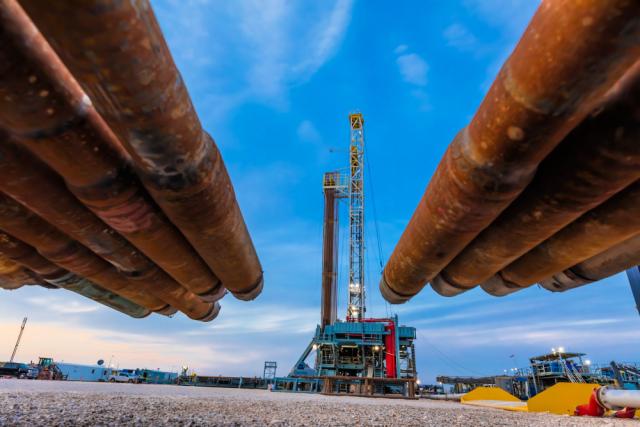
A drilling rig in the Permian Basin operated by WPX Energy, a company that played a part in the recent wave of consolidation among independent E&Ps through its merger with Devon Energy. (Source: Hart Energy)
Historically, oil and gas companies face many challenges—it’s considered part of the gig. However, in recent years, those challenges started to evolve and, subsequently, so have U.S. independent E&Ps.

David Clark, vice president of upstream research at Wood Mackenzie, recently shared his take on the new pressures facing oil and gas and what that means for the future U.S. E&P landscape. In particular, Clark notes the M&A that has occurred over the past year reveal three main strategies U.S. independents are pursuing to remain viable.
Hart Energy: In light of many pressures (ESG, anti-carbon, energy transition, shale maturity, etc.), what does the future independent E&P look like in 10 years?
David Clark: The 2030 E&P landscape will likely be dominated by fewer, larger companies.
There isn’t a one-size-fits-all template for the U.S. independent of the future, but there are likely some shared characteristics that will enable survivors to navigate the risks and stakeholder pressures of the next decade. Strategies to 2030 are being shaped by the economics of a maturing industry, the energy transition, and investor pressure to show capital discipline, maintain resilience, and deliver cash back to shareholders through the commodity price cycle.
I’d say the key characteristics are sufficient scale; a balance sheet and portfolio that are resilient through the price cycle (and therefore able to deliver cash to shareholders through the cycle); a good governance framework; and a clear and viable energy transition strategy.
The different strategies we are seeing diverge largely around the importance of portfolio diversity—some think it is critical to dealing with risk, others see it as diluting their investment proposition.
The U.S. M&A that has occurred over the last 12 months give us a sense of the templates for different strategies the independents are pursuing to remain viable and investable out to 2030. For sake of simplicity, I think they fall into three groups.
First, you’ve got the mini-majors, who value diversity and optionality, but who seek economies of scale in the Lower 48 portion of their business. ConocoPhillips-Concho.
Then you’ve got Lower 48 companies who know they need to get bigger, think diversity across basins and/or commodities is important for risk management, but don’t want to stray from their core unconventional competency. Devon-WPX, Cimarex-Cabot.
Finally, you’ve got the pure-play scale builders, who think investors will still value very-focused investment stories, but who understand they need scale and inventory depth to remain viable. Pioneer-Parsley/DoublePoint, Diamondback-QEP/Guidon, and the interesting bankruptcy emerging combination of Bonanza Creek-HighPoint-Extraction Oil & Gas-Crestone peak in the D-J Basin/Niobrara.
Given the increasing competitive advantages of scale, there is a sense now that you either get bigger or you exit. That may be a bit extreme, but for many that is probably true.
Within a basin, you likely get increasing economies of scale to at least 1 Mboe/d (which is one reason why you see the majors with volumes targets that ramp to that level before they flatten). For companies that are pursuing a basin pure-play model (Pioneer, Diamondback), we have seen an urgency to acquiring their way to sufficient scale, since the market will no longer tolerate aggressive organic growth.
A clear and viable energy transition strategy. Ten years from now, surviving companies will need to be well down the road to decarbonizing their own operations. They will have come close to eliminating flaring and venting (other than for safety/emergencies) and methane leakage, and then moved beyond that low hanging fruit to electrification of the oil field. CCUS (carbon capture, utilization and sequestration) will be on the horizon as an increasingly economically viable decarbonization technology over the next decade (2031 to 2040). The fewer, larger companies that remain find it easier to collaborate on regional CCUS and other decarbonization projects that benefit multiple operators and other adjacent industries.
Read more about The Future of the Independent E&P in the cover story of the Oil and Gas Investor September issue.

Hart Energy: How should public and private independent E&Ps change? How will they change?
Clark: Publicly-traded companies have been changing strategy and behavior, some of them dramatically so, over the last year and a half. The combination of investor/market pressure and the pandemic downturn moved the sector from a state of semi-denial to acceptance, with regards to both investor expectations and the growing risks related to the energy transition. The public independents will need to sustain their new-found capital discipline and shareholder-friendly return of capital as oil prices rise to firm up their credibility, but they are off to a good start. In terms of the energy transition they have been fairly aggressive in playing catch-up to the rest of the industry this year. Many have laid out Scope 1 and 2 net-zero targets (though many are heavily relying on carbon offsets, which still have major credibility issues), established fairly meaningful medium-term mileposts, and moved their energy transition plans to the front of the investor slide deck. But investors and lenders are under pressure and moving fast on this front too, and to maintain access to capital the independents will need to be even more ambitious, and to execute well on the targets they have set.
Privates arguably feel less direct pressure to change, though the better way to phrase it may be that they have a different set of pressures. While they aren’t worried about equity market investors or as concerned about their public reputation, they do have to worry about access to capital and the cost of capital. Lenders’ standards are rising, and the cost of capital will rise over time as well as climate-related risks build. They also need to consider the demands of their customers (for example, into LNG export where buyers my reject cargoes based on emissions intensity of the gas), and risks from regulations and policy changes. So, privates may not be as aggressive on their energy transition plans as the publicly traded companies, but they will need to keep pace with important stakeholder expectations.
Hart Energy: What is the threat, and the opportunity?
Clark: There are many threats—access to capital, rising cost of capital, the cost of addressing the energy transition, the cost of not addressing the energy transition, the inevitable peak and then decline in demand for oil, and then later gas.
In terms of long-term demand, a world on a decarbonization path—whether it is the Paris-aligned 1.5 C or 2 C paths, or the more realistic “base case” path that is aspirational but falling short of Paris-aligned targets—does not need hundreds (or in the case of the worldwide total, thousands) of oil and gas companies chasing volumes.
The opportunities depend on the company—for many smaller operators, the opportunity will be to identify the appropriate time to exit. For the largest companies, the opportunity will be to forge a viable path through consolidation, and possibly through investments in an emerging carbon-as-a-business. For those in the middle, the opportunity may be to extract maximum value out of a portfolio of advantaged assets, remaining to the left of the supply curve as demand for oil starts its decline.
Hart Energy: Are we heading for a time of only 2-3 big companies per basin, a la Pioneer Natural Resources or ConocoPhillips?
Clark: Consolidation would be happening in the sector regardless of the energy transition, given the maturity of the key basins and the immense pressure from investors to restrain growth investment and deliver free cash flow to shareholders through the cycle. But the energy transition puts the pressure for consolidation into over-drive.
We are maybe halfway there on Permian consolidation. Right now, a dozen companies hold 80%-85% of the value in the basin. That dozen will likely consolidate a lot of that remaining 20%. And combinations among those dozen companies (which include the U.S. majors) will probably bring the number of important players down further. By 2030, there may be just a half-dozen key players in the Permian. Other mature basins may have fewer. Scott Sheffield has talked about having just five U.S. E&Ps with sufficient scale to be investable by 2030. It may be more than that, but probably not more than 10.
Consolidation creates a healthier sector for navigating the energy transition. Companies with scale typically have greater resilience through business and price cycles, and therefore greater support from capital markets. Fewer and bigger companies will rationalize development and production, lower capital requirements, and enable better capital stewardship. It will be easier to collaborate on energy transition issues—regional consortia for CCUS, oil field electrification, policy engagement with government—with a handful of key players.
Recommended Reading
Hess Corp. Boosts Bakken Output, Drilling Ahead of Chevron Merger
2024-01-31 - Hess Corp. increased its drilling activity and output from the Bakken play of North Dakota during the fourth quarter, the E&P reported in its latest earnings.
The OGInterview: Petrie Partners a Big Deal Among Investment Banks
2024-02-01 - In this OGInterview, Hart Energy's Chris Mathews sat down with Petrie Partners—perhaps not the biggest or flashiest investment bank around, but after over two decades, the firm has been around the block more than most.
Some Payne, But Mostly Gain for H&P in Q4 2023
2024-01-31 - Helmerich & Payne’s revenue grew internationally and in North America but declined in the Gulf of Mexico compared to the previous quarter.
Petrie Partners: A Small Wonder
2024-02-01 - Petrie Partners may not be the biggest or flashiest investment bank on the block, but after over two decades, its executives have been around the block more than most.
BP’s Kate Thomson Promoted to CFO, Joins Board
2024-02-05 - Before becoming BP’s interim CFO in September 2023, Kate Thomson served as senior vice president of finance for production and operations.





